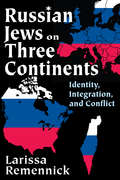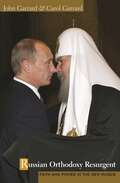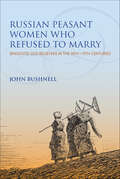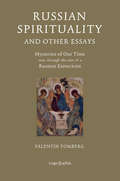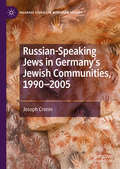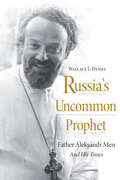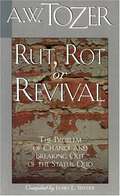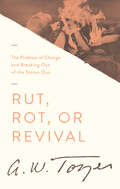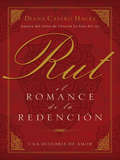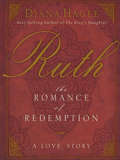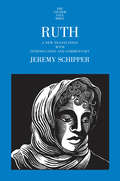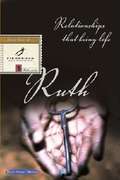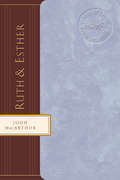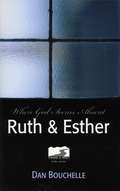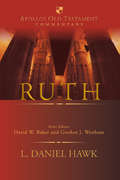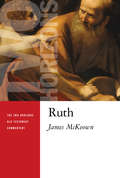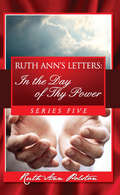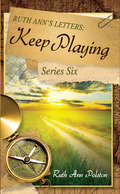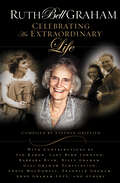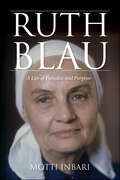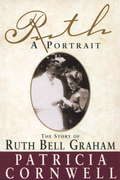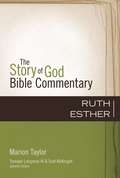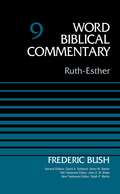- Table View
- List View
Russian Jews on Three Continents: Identity, Integration, and Conflict
by Larissa RemennickIn the early 1990s, more than 1.6 million Jews from the former Soviet Union emigrated to Israel, the United States, Canada, Germany, and other Western countries. Larissa Remennick relates the saga of their encounter with the economic marketplaces, lifestyles, and everyday cultures of their new homelands, drawing on comparative sociological research among Russian-Jewish immigrants.Although citizens of Jewish origin ostensibly left the former Soviet Union to flee persecution and join their co-religionists, Israeli, North American, and German Jews were universally disappointed by the new arrivals' tenuous Jewish identity. In turn, Russian Jews, whose identity had been shaped by seventy years of secular education and assimilation into the Soviet mainstream, hoped to be accepted as ambitious and hard working individuals seeking better lives. These divergent expectations shaped lines of conflict between Russian-speaking Jews and the Jewish communities of the receiving countries.Since her own immigration to Israel from Moscow in 1991, Remennick has been both a participant and an observer of this saga. This is the first attempt to compare resettlement and integration experiences of a single ethnic community (former Soviet Jews) in various global destinations. It also analyzes their emerging transnational lifestyles. Written from an interdisciplinary perspective, this book opens new perspectives for a diverse readership, including sociologists, anthropologists, political scientists, historians, Slavic scholars, and Jewish studies specialists.
Russian Orthodoxy Resurgent: Faith and Power in the New Russia
by Carol Garrard John GarrardRussian Orthodoxy Resurgent is the first book to fully explore the expansive and ill-understood role that Russia's ancient Christian faith has played in the fall of Soviet Communism and in the rise of Russian nationalism today. John and Carol Garrard tell the story of how the Orthodox Church's moral weight helped defeat the 1991 coup against Gorbachev launched by Communist Party hardliners. The Soviet Union disintegrated, leaving Russians searching for a usable past. The Garrards reveal how Patriarch Aleksy II--a former KGB officer and the man behind the church's successful defeat of the coup--is reconstituting a new national idea in the church's own image. In the new Russia, the former KGB who run the country--Vladimir Putin among them--proclaim the cross, not the hammer and sickle. Meanwhile, a majority of Russians now embrace the Orthodox faith with unprecedented fervor. The Garrards trace how Aleksy orchestrated this transformation, positioning his church to inherit power once held by the Communist Party and to become the dominant ethos of the military and government. They show how the revived church under Aleksy prevented mass violence during the post-Soviet turmoil, and how Aleksy astutely linked the church with the army and melded Russian patriotism and faith. Russian Orthodoxy Resurgent argues that the West must come to grips with this complex and contradictory resurgence of the Orthodox faith, because it is the hidden force behind Russia's domestic and foreign policies today.
Russian Peasant Women Who Refused to Marry: Spasovite Old Believers in the 18th–19th Centuries (Indiana-Michigan Series in Russian & East European Studies)
by John BushnellJohn Bushnell's analysis of previously unstudied church records and provincial archives reveals surprising marriage patterns in Russian peasant villages in the 18th and 19th centuries. For some villages the rate of unmarried women reached as high as 70 percent. The religious group most closely identified with female peasant marriage aversion was the Old Believer Spasovite covenant, and Bushnell argues that some of these women might have had more agency in the decision to marry than more common peasant tradition ordinarily allowed. Bushnell explores the cataclysmic social and economic impacts these decisions had on the villages, sometimes dragging entire households into poverty and ultimate dissolution. In this act of defiance, this group of socially, politically, and economically subordinated peasants went beyond traditional acts of resistance and reaction.
Russian Spirituality And Other Essays: Mysteries of Our Time seen through the eyes of a Russian Esotericist
by Valentin TombergThese wisdom-filled articles are gems offered us by the Russian esotericist Valentin Tomberg (1900-1973). Written in the 1930s, at the time he was also writing important studies on the Old Testament, New Testament, and the Apocalypse, these early articles presage Tomberg's later, more mature works on Christian Hermeticism. This was the 'anthroposophical' phase of his life, which ended during World War II, when he followed Christ's call to join the Catholic Church in order to bring the Christian esotericism of the Church of John into the exoteric Church of Peter--a step that truly represented a sacrifice on the part of this remarkable man. For in following this call of Christ to the Catholic Church, Tomberg took the step of leaving his karmic community--that of the anthroposophical movement founded by Rudolf Steiner (1861-1925). This step was a fulfillment of the words of Christ, of the Risen One, to Peter concerning John: 'If it is my will that he should wait until I come again, what is that to thee?' (John 21:22). These words relate to the task of the Church of John to 'wait'--that is, to cultivate the esoteric teachings 'behind the scenes'--until the onset of Christ's Second Coming, which began during the 1930s, when they could begin to emerge by bringing the esoteric teachings into the Church. For students of Christian Hermeticism, these early articles by the founder of this new spiritual stream reveal in particular something of the esoteric teachings underlying the author's Russian spirituality. The penetrating insights they offer are seeds that subsequently blossomed in his later works. As well as being of interest to students of Christian Hermeticism, these essays are relevant to anyone interested in Russian spirituality and, moreover, to everyone interested in esoteric perspectives concerning the present situation of humanity. The author of this work was a spiritually enlightened teacher whose care and concern extended beyond the plight of the Russian people under Soviet communism to include the challenges facing every human being in our time. Understood as a manual for enlightenment, to be worked with meditatively over and over again, this work is one of the great treasures of humanity's spiritual literature--a priceless jewel for every spiritual seeker in our time
Russian-Speaking Jews in Germany’s Jewish Communities, 1990–2005 (Palgrave Studies in Migration History)
by Joseph CroninThis book explores the transformative impact that the immigration of large numbers of Jews from the former Soviet Union to Germany had on Jewish communities from 1990 to 2005. It focuses on four points of tension and conflict between existing community members and new Russian-speaking arrivals. These raised the fundamental questions: who should count as a Jew, how should Jews in Germany relate to the Holocaust, and who should the communities represent? By analyzing a wide range of source material, including Jewish and German newspapers, Bundestag debates and the opinions of some prominent Jewish commentators, Joseph Cronin investigates how such conflicts arose within Jewish communities and the measures taken to deal with them. This book provides a unique insight into a Jewish population little understood outside Germany, but whose significance in the post-Holocaust world cannot be underestimated.
Russia’s Uncommon Prophet: Father Aleksandr Men and His Times
by Wallace DanielThis lucidly written biography of Aleksandr Men examines the familial and social context from which Men developed as a Russian Orthodox priest. Wallace Daniel presents a different picture of Russia and the Orthodox Church than the stereotypes found in much of the popular literature. Men offered an alternative to the prescribed ways of thinking imposed by the state and the church. Growing up during the darkest, most oppressive years in the history of the former Soviet Union, he became a parish priest who eschewed fear, who followed Christ's command "to love thy neighbor as thyself," and who attracted large, diverse groups of people in Russian society. How he accomplished those tasks and with what ultimate results are the main themes of this story. Conflict and controversy marked every stage of Men's priesthood. His parish in the vicinity of Moscow attracted the attention of the KGB, especially as it became a haven for members of the intelligentsia. He endured repeated attacks from ultraconservative, anti-Semitic circles inside the Orthodox Church. Fr. Men represented the spiritual vision of an open, non-authoritarian Christianity, and his lectures were extremely popular. He was murdered on September 9, 1990. For years, his work was unavailable in most church bookstores in Russia, and his teachings were excoriated by some both within and outside the church. But his books continue to offer hope to many throughout the world—they have sold millions of copies and are testimony to his continuing relevance and enduring significance. This important biography will appeal to scholars and general readers interested in religion, politics, and global affairs.
Rut, Rot or Revival: The Problem of Change and Breaking Out of the Status Quo
by A. W. Tozer James L. SnyderIn this powerful collection of verbatim sermons, A. W. Tozer deals with revival issues: the problem of "sleeping" Christians controlling church affairs, the problem of getting out of the ecclesiastical rut, the difficulty of breaking the status quo and more. This is Tozer, pulpit-style -- humor included.
Rut, Rot, or Revival: The Problem of Change and Breaking Out of the Status Quo
by A. W. Tozer"If the messages in this book were read and acted upon by every pastor and church member, we would have the revival for which Dr. Tozer fervently prayed, and for which many of us are praying today." — Warren Wiersbe"The church should be a healthy, fruitful vineyard that will bring honor to Christ," says A. W. Tozer. But to do so, we as individuals must stop accepting the status quo and get out of our spiritual ruts.In Rut, Rot, or Revival, Tozer describes the signs of being in a spiritual rut, the reasons we get into them, how to get out, and, most importantly, why we need to get out now.
Rut, Rot, or Revival: The Problem of Change and Breaking Out of the Status Quo
by A. W. Tozer"If the messages in this book were read and acted upon by every pastor and church member, we would have the revival for which Dr. Tozer fervently prayed, and for which many of us are praying today." — Warren Wiersbe"The church should be a healthy, fruitful vineyard that will bring honor to Christ," says A. W. Tozer. But to do so, we as individuals must stop accepting the status quo and get out of our spiritual ruts.In Rut, Rot, or Revival, Tozer describes the signs of being in a spiritual rut, the reasons we get into them, how to get out, and, most importantly, why we need to get out now.
Rut: El romance de la redención
by Diana HageeLa amistad, la devoción, la reconciliación, la falta de hijos, la pobreza, la fe, el compromiso, el romance y el amor. Estos asuntos que las mujeres enfrentan en sus vidas en la actualidad fueron los mismos asuntos que Rut enfrentó hace siglos.En el libro Rut, El romance de la redención, Diana Hagee lleva a las mujeres a través del libro de Rut y explora la ponderosa promesa de la gracia redentora de Dios para cada mujer y para toda la humanidad. Cada capítulo detalla la lucha de Israel y de la humanidad entera al buscar respuestas a nuestro vacío, nuestra soledad y nuestra separación de Dios.Los personajes históricos muestran la historia de redención de Dios, culminando con el romance entre Rut (la heroína) y Boaz (el pariente redentor).
Ruth
by Diana HageeFriendship, devotion, reconciliation, childlessness, poverty, faith, commitment, romance, and love. These are issues many women will face in their lives today, and they are the same issues Ruth dealt with centuries ago. In this delightful book, Diana Hagee leads women through the book of Ruth and explores the powerful promise of God's redemptive grace for each woman and for all mankind. Each chapter details the struggle of Israel and our entire humanity as we seek to find the answers to our emptiness, hunger, loneliness and estrangement from God.The historic characters show God's story of redemption, culminating in the romance between Ruth (the heroine) and Boaz (the kinsman redeemer).
Ruth
by Jeremy SchipperIn recent years, students, scholars, and lay readers of the Bible have been increasingly drawn to the book of Ruth. Delving deeply into the complicated nature of its characters' relationships, Jeremy Schipper encourages readers to consider the roles that categories of difference involving gender, disability, household status, ethnicity, and sexual desire play throughout the text. This fresh translation of the deceptively simple book is more literal and less idiosyncratic than its predecessors. Combining the traditional strengths of the Anchor Yale Bible series with the latest research in biblical scholarship, Schipper's much-needed volume will succeed Edward F. Campbell's 1975 edition as the go-to commentary for years to come.
Ruth
by Ruth Haley BartonBring Hope, Faith, and Love to Your Relationships. The biblical character of Ruth was striking in her capacity to bring life to her relationships. Even in the midst of tragedy and difficulty, her presence blessed and influenced friends and strangers in her community, the man she grew to love, her children, and her in-laws. This six-week Fisherman Bible Studyguide uses Ruth's story to help you reflect on your own relationships and the ways in which God might be inviting you to move different ways--ways that will lead you into life-giving patterns of relating with others. Fisherman Bible Studyguides offer: * Penetrating questions that generate discussion* Flexible format for group or individual needs* Helpful leader's notes* Emphasis on daily application of Bible truthFrom the Trade Paperback edition.
Ruth & Esther (MacArthur Bible Studies)
by John MacarthurThese study guides, part of a 16-volume set from noted Bible scholar John MacArthur, take readers on a journey through biblical texts to discover what lies beneath the surface, focusing on meaning and context, and then reflecting on the explored passage or concept. With probing questions that guide the reader toward application, as well as ample space for journaling, The MacArthur Bible Studies are an invaluable tool for Bible Students of all ages.
Ruth & Esther: When God Seems Absent
by Dan BouchelleStreams of Mercy: Ruth and Esther -- When God seems absent. The Streams of Mercy Series is dedicated to helping God's people drink deeply from his life giving Word. A fast-paced study of the Old Testament books of Ruth and Esther.
Ruth (Apollos Old Testament Commentary Series)
by L. Daniel HawkOn the surface, the book of Ruth tells the tale of an unlikely marriage between a destitute Moabite widow and an upstanding citizen of a Judean village. The deeper import of the story, however, has to do with the internal boundaries that define the people of God. Is Israel a closed community, held together exclusively by bonds of kinship, or a nation that welcomes faithful outsiders into its sphere of belonging? Ruth appropriates marriage as the symbolic vehicle of a transformation in Israel?s self-understanding from a community articulated by Naomi?s declaration that her daughters-in-law marry within their own people, to the acclamations by the people of Bethlehem that endorse Boaz?s marriage to a Moabite. L. Daniel Hawk undertakes a detailed narrative analysis of Ruth that goes beyond the description of its content and stylistic features to illumine its deep structure and use of metaphor. Informed by contemporary studies on ethnicity, he discovers a work of remarkable sophistication that employs a story of intermarriage to address opposing ideas of Israelite identity. Hawk?s meticulous attention to patterned structures, stylistic devices and characterization reveals the strategy by which the narrator constructs a vision of Israel that looks beyond rigid internal boundaries to the welcome of faithful foreigners as agents of blessing.
Ruth (The Two Horizons Old Testament Commentary (THOTC))
by James McKeownIn this commentary James McKeown approaches the book of Ruth as part of the whole canon of Scripture, exploring not only the content of the book itself but also its relationship to other biblical books. He shows in particular how Ruth overflows with allusions to Genesis. The themes of “blessing,” “seed,” and “land” are common to both books, and studying Genesis and Ruth together provides profound insights into the providential working of God to fulfill the promises made to Abraham, Isaac, and Jacob.In addition to his exegetical commentary on the text of Ruth, McKeown provides useful background material on how the book has been interpreted throughout history, including Jewish interpretation, and he focuses on Ruth’s theology and its application. His discussion also touches on such related topics as universalism, feminist studies, and the missiological significance of the book of Ruth.McKeown’s insightful commentary will enable students, pastors, and laypeople to better understand the ancient book of Ruth so that they can better apply its message and wisdom today.
Ruth Ann's Letters: In the Day of Thy Power
by Ruth Ann PolstonIn The Day of Thy Power is an effort to demon demonstrate the rule of God, particularly defined as revival.
Ruth Ann's Letters: Learning from the Lost and Found Bin, Series Six
by Ruth Ann PolstonThis book is for the lost and found. Some of us may be lost now, and all of us have been lost at one time or another. For those of us who are now found, we have "lost and found bin." These are the memories, the hurts, and the lesson we learned from being lost. It's tempting to act like our lost and found bin doesn't exist--and sometimes it's painful to revisit it. May this book remind you that God wants to use your lost and found bin to help someone else. Don't be afraid of it. For those of us who are lost in some way, take heart! We have a divine Guide Who wants to lead us home. Whether we are lost in confusion, lost in pain, lost in circumstances, or completely lost from our Maker, there is hope for us in Jesus Christ.
Ruth Bell Graham: Celebrating An Extraordinary Life
by Jan Karon Barbara Bush Stephen Griffith Lady Bird JohnsonFriends and family of Ruth Bell Graham share their fondest thoughts and memories about the woman they know as mother, wife, grandmother, teacher, prayer partner and friend. Reminiscent of the best-selling Footprints of a Pilgrim, Ruth Bell Graham is a tender and touching portrait of Ruth Bell Graham as seen in the lives of those who know and love her. Reflecting both her roots as the child of missionary parents, her commitment to family, her love of the Lord and her ongoing personal ministry, this tribute to Ruth Bell Graham is a behind the scenes look at her unique lifetime of service to the Lord that includes personal speaking, writing and mentoring others for the cause of Christ.
Ruth Blau: A Life of Paradox and Purpose (Perspectives on Israel Studies)
by Motti InbariRuth Blau: A Life of Paradox and Purpose explores the life of a curious, if not mysterious, character in modern Jewish history. Born a French Catholic, Ruth Blau (Ben-David) (1920–2000) lived a constantly twisting life. During World War II, Blau was active in the French Resistance, and under their command, she joined the Gestapo as a double agent. After the war, she studied philosophy as a PhD candidate at the Sorbonne during the 1950s. After converting to Judaism and moving to Israel in 1960, Blau was involved in concealing Yossele Schumacher, a seven-year-old child, as part of a militant conflict between ultra-Orthodox and secular Jews in Israel. In 1965, despite a huge scandal, she married Amram Blau, head of the anti-Zionist ultra-Orthodox Neturei Karta. After the death of her husband in 1973, Blau took upon herself to travel to Arab countries to help the Jewish communities in distress in Lebanon and Iran, where she met Yasser Arafat, head of the Palestinian Liberation Organization, and his deputy Abu Jihad. But the most significant connections she made were in Iran. In 1979, she met with the leader of the Iranian revolution, Ayatollah Khomeini.Ruth Blau: A Life of Paradox and Purpose represents the first full-length biography of this remarkable woman. Drawing on a trove of archival materials and interviews with those who knew Ruth, Motti Inbari offers a complex, multifaceted portrait of a woman undertaking a remarkable and influential journey through modern European and Middle Eastern history.
Ruth, A Portrait: The Story of Ruth Bell Graham (Inspirational Ser.)
by Patricia Daniels CornwellRuth Bell Graham is known as the wife of evangelist Billy Graham. It was Ruth who influenced Billy, as his most trusted life-partner. InRuth, a Portrait,we meet this fascinating and remarkable woman. Brimming with anecdotes, this is a breathtaking journey, with stops at many of this century's epoch-making events. The childhood years of the future Mrs. Billy Graham were spent light-years away--in the China of the 1920s and 1930s. The daughter of medical missionaries, she and her family were caught in a crucible of unspeakable hardship; in addition to pestilence and plague, there was the unstable political and military turmoil surrounding the Nationalist government, the Communists, and the Japanese invaders. These hazardous realities shaped Ruth Bell and her family, a family inured to difficulties, but buoyed up by their deep belief in God's abiding will. Virtually raised by the Grahams, the author is a repository of Ruth Bell Graham's stories and has seen firsthand the spirit of this courageous woman. Patricia Cornwell not only gives readers a full, rounded, and intimate portrait of Ruth Bell Graham, but also insight into the life of the Graham family and particularly Billy Graham.
Ruth, Esther (The Story of God Bible Commentary)
by Marion Ann TaylorA new commentary for today's world, The Story of God Bible Commentary explains and illuminates each passage of Scripture in light of the Bible's grand story.The first commentary series to do so, SGBC offers a clear and compelling exposition of biblical texts, guiding everyday readers in how to creatively and faithfully live out the Bible in their own contexts. Its story-centric approach is ideal for pastors, students, Sunday school teachers, and laypeople alike.Each volume employs three main, easy-to-use sections designed to help readers live out God's story:LISTEN to the Story: Includes complete NIV text with references to other texts at work in each passage, encouraging the reader to hear it within the Bible's grand story.EXPLAIN the Story: Explores and illuminates each text as embedded in its canonical and historical setting.LIVE the Story: Reflects on how each text can be lived today and includes contemporary stories and illustrations to aid preachers, teachers, and students. —Ruth, Esther—The book of Ruth presents a compelling account of how most of us experience God in our everyday lives. We see God working indirectly behind the scenes, giving us a theology of divine and human cooperation, as those who pray for God&’s blessings participate in answering their own petitions as well as the prayers of others. In Esther&’s story, we recognize our own world today, often experiencing it as a place where God seems hidden. Her book challenges us in unique ways.Edited by Scot McKnight and Tremper Longman III, and written by a number of top-notch theologians, The Story of God Bible Commentary series will bring relevant, balanced, and clear-minded theological insight to any biblical education or ministry.
Ruth, Woman of Courage
by Paula ParrisAs in the Old Testament Book of Ruth, after losing her husband, Ruth, a foreigner, follows her widowed, mother-in-law, Naomi, to a distant place. Through Naomi's instructions, Ruth finds and marries Boaz, her kin's man, redeemer. The writer extends this narrative by writing about Ruth's and Boaz' son who becomes the progenitor of the Messiah. According to the author, "Ruth, the stranger from Moab, became one of the ancestors of Jesus, God's own Son. Because of her courage, love, and devotion, Ruth is still remembered. Ruth was courageous in many ways. She was ready to leave her home, her family, and her friends to move to a new land with Naomi. Unafraid, Ruth went to the fields to find food. Later Ruth followed Naomi's unusual instructions and went to the threshing floor at night. Putting behind her the idol worship of her own people, Ruth trusted the one true God. And God honored Ruth's love and obedience by blessing her in a very special way ..."
Ruth-Esther, Volume 9
by Ralph P. Martin David Allen Hubbard Glenn W. Barker John D. Watts Dr Frederic W. BushThe Word Biblical Commentary delivers the best in biblical scholarship, from the leading scholars of our day who share a commitment to Scripture as divine revelation. This series emphasizes a thorough analysis of textual, linguistic, structural, and theological evidence. The result is judicious and balanced insight into the meanings of the text in the framework of biblical theology. These widely acclaimed commentaries serve as exceptional resources for the professional theologian and instructor, the seminary or university student, the working minister, and everyone concerned with building theological understanding from a solid base of biblical scholarship. <P><P>Overview of Commentary Organization Introduction—covers issues pertaining to the whole book, including context, date, authorship, composition, interpretive issues, purpose, and theology.Each section of the commentary includes:Pericope Bibliography—a helpful resource containing the most important works that pertain to each particular pericope. Translation—the author’s own translation of the biblical text, reflecting the end result of exegesis and attending to Hebrew and Greek idiomatic usage of words, phrases, and tenses, yet in reasonably good English.Notes—the author’s notes to the translation that address any textual variants, grammatical forms, syntactical constructions, basic meanings of words, and problems of translation.Form/Structure/Setting—a discussion of redaction, genre, sources, and tradition as they concern the origin of the pericope, its canonical form, and its relation to the biblical and extra-biblical contexts in order to illuminate the structure and character of the pericope. <P>Rhetorical or compositional features important to understanding the passage are also introduced here.Comment—verse-by-verse interpretation of the text and dialogue with other interpreters, engaging with current opinion and scholarly research.Explanation—brings together all the results of the discussion in previous sections to expose the meaning and intention of the text at several levels: (1) within the context of the book itself; (2) its meaning in the OT or NT; (3) its place in the entire canon; (4) theological relevance to broader OT or NT issues.General Bibliography—occurring at the end of each volume, this extensive bibliography contains all sources used anywhere in the commentary.
